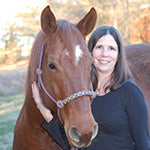Horse owners often hear the phrase “forage-based diet” when it comes to doing what is best for their horses’ nutritional needs.
Horses in the wild graze for 20+ hours a day, while eating a variety of forages. No matter whether our horses are high-level athletes or pasture pets, they are still designed for forage to be the bulk of their diets. A forage-based diet is one that takes into consideration that the horse’s GI tract is designed to process forage as the basis of its nutritional intake.
While forage should be the foundation, this phrase doesn’t mean that forage is the only thing that our horses nutritionally need. Forage-based diets should not be confused with forage-only diets. Owners must honor how horses evolved and also understand the needs of the modern horse.
Sources of Forage in a Horse’s Diet
Horses need a minimum of 1.5% and up to 2.5% of their body weight in forage per day to maintain a healthy digestive tract. This is best provided by long-stem forage, such as pasture and hay. However, we all know that some horses need more or different nutrition than others and that all forages are not created equally.
Some horses might have dental issues, poor digestive tract health, or require greater or different nutrients depending on the jobs that they do. For example, a pregnant mare doesn’t have the same nutrient requirements as a mature gelding at pasture or a high-level competition horse.
The senior horse that has dental issues or is running out of teeth to chew is a great example of a horse that can’t use long-stem forage as its dietary foundation. In that case, soaking hay pellets or hay cubes can supply forage. Using a complete feed that is forage-based can also help those horses get the forage they need. Complete feeds are designed to be high in digestible fiber. The sources of that digestible fiber may include soy hulls, dehydrated alfalfa meal, and beet pulp, which are all very digestible in the horse’s hind gut, so the horse can utilize those sources when they are unable to chew pasture or hay.
So, what if you have a horse that can eat pasture or hay, but you are living through a drought or hay shortage? In these cases, you might need to cut back on the amount of hay you normally feed and supplement with another source of fiber, such as a processed forage option, like hay pellets or hay cubes. Your management plan might be to supply 70% of their diet with their normal hay and 30% of their forage needs with one of the other fiber sources mentioned above.
Filling In the Nutritional Gaps of a Horse’s Diet
As we consider the phrase “forage-based diet,” the emphasis should be on “based”. That’s because even the best-quality forage—whether it is grass or hay—still doesn’t supply all the nutrients a horse needs.
Your horse may be maintaining its weight on pasture or hay, but can lack in certain amino acids, trace minerals and vitamins needed to support optimal health and performance. Ration balancers are great solutions to these horses. They provide a low rate of feeding along with the nutrients needed to “complete” the forage diet your horse has.
There are many horses that just can’t get enough calories from a forage-only diet to remain at a healthy body weight. Whether their metabolism is higher or they are in a demanding work schedule that requires more energy to perform, owners have to determine the best horse feed diet to supply these horses with the necessary calories.
Filling in nutritional gaps for horses can be a little confusing and overwhelming. When you start trying to use a pinch of this and a dash of that, often you do more harm than good by unbalancing the nutrients in your horse’s diet. And keep in mind that you probably can’t “piece together” all of those needed vitamins and minerals as cheaply as you could get them in a ration balancer designed by nutritionists for your horse’s needs.
Some owners feel like they can get a good-quality horse feed and just feed less than what is recommended on the bag to keep their horses from getting too many calories. Here’s why that doesn’t work…
Horse feeds are calculated to be fed at a certain amount per day to supply the horse with the proper amounts of vitamins, minerals, and amino acids.
If the horse feed label says to feed at a rate of four pounds per day, but the horse is either getting fat or not maintaining its weight on forage plus the horse feed, then you are not supplying the appropriate amount of nutrients and calories that horse needs.
It’s best to use a horse feed that is balanced for not only forage, but the activity and caloric needs of that horse. Today’s most popular horse feeds are designed with a base of good, digestible fiber. Typically, they are lower in non-structural carbohydrates (NSC) because calories are being provided through fat, as well as high-quality fiber.
Horse Feeds Based on Forage Type
Because horse owners have different hays available to them depending on where they are in the country, Tribute® offers feeds and supplements based on the type of forage your horse is eating. For example, Alfa Essentials® is a pelleted, low-NSC ration balancer for horses eating alfalfa-based forage diets. Tribute® offers many other ration balancer feeds for various horse needs (young and growing, senior, competitive) as well as a variety of complete feeds for various classes of equids.
Ultimately, horse owners want to look at how to maximize the quantity and quality of forage fed to their horses, then look for ways to fill in the nutrition gaps. If you have questions about your horse’s feeding regimen, reach out to our team at any time for a personalized feeding plan.

